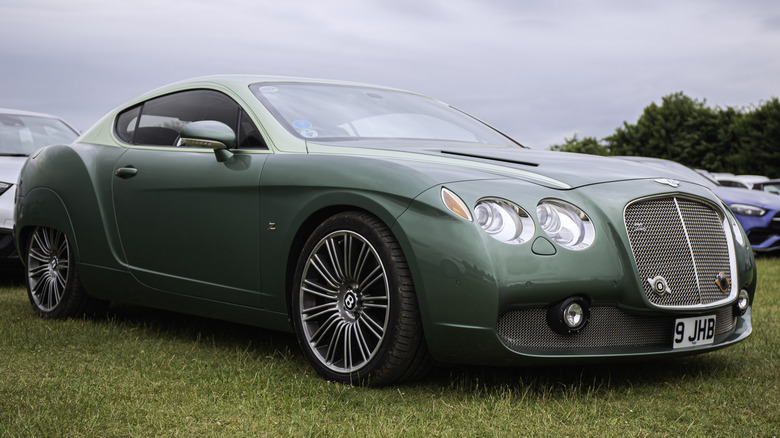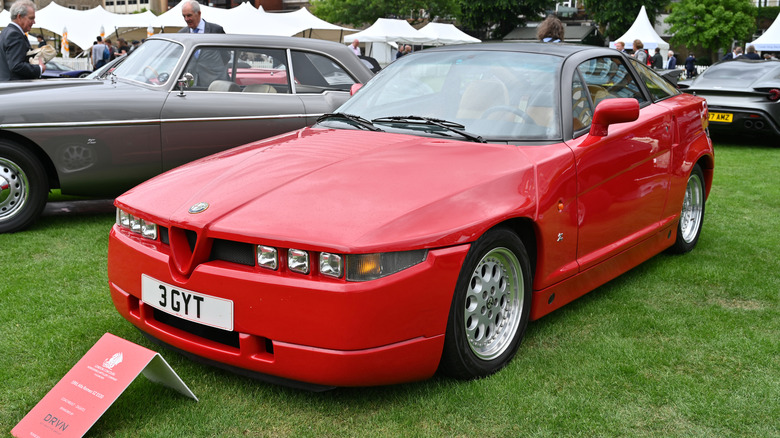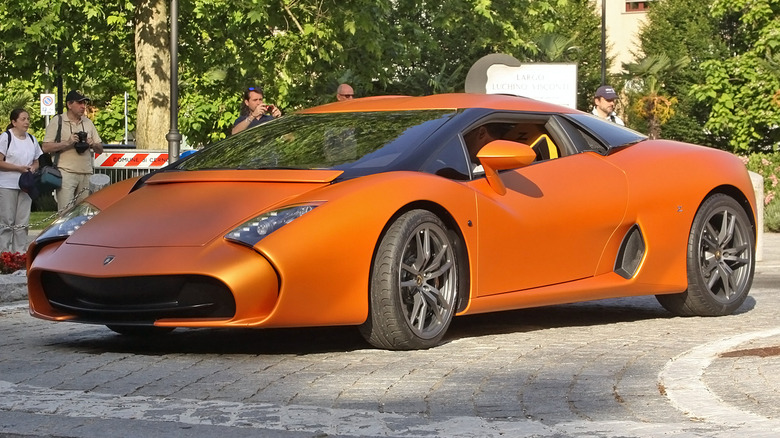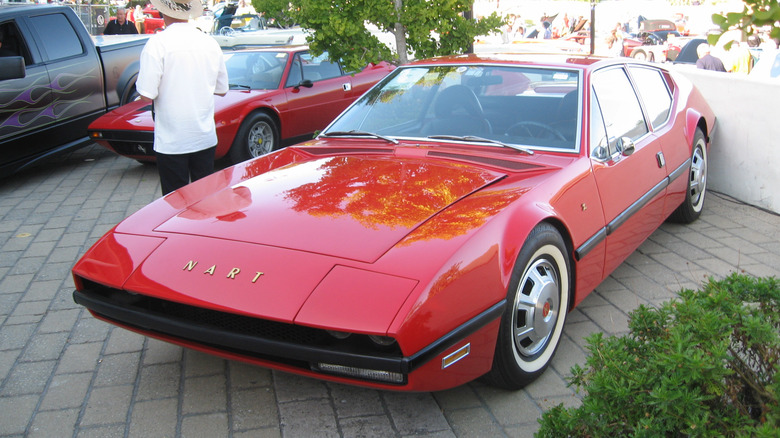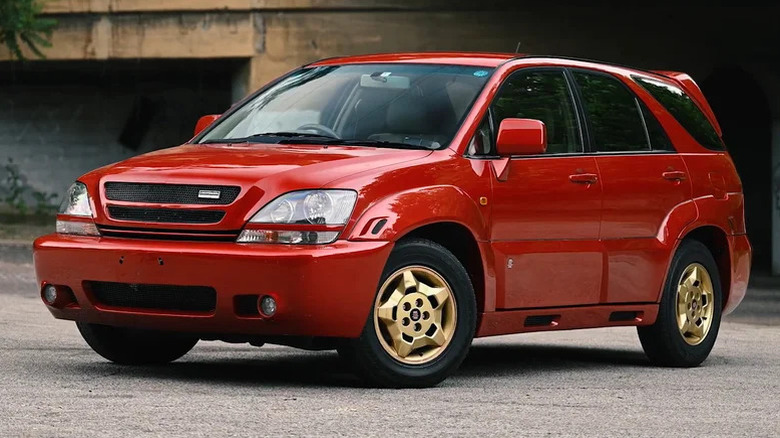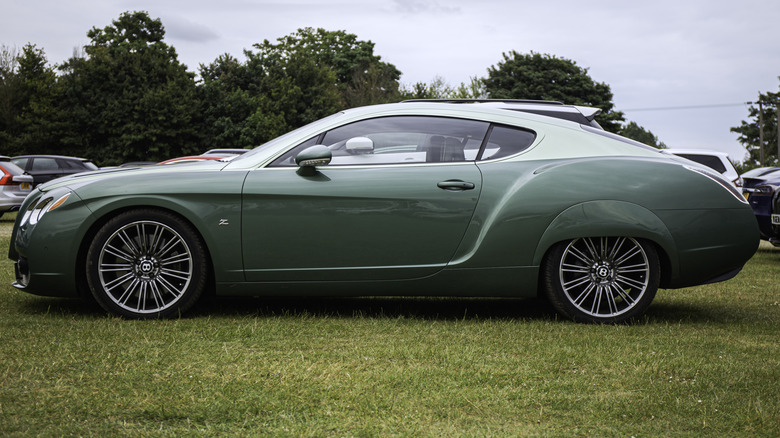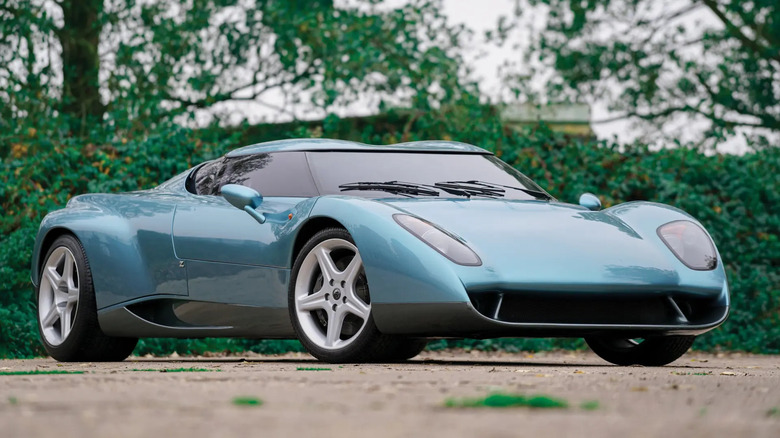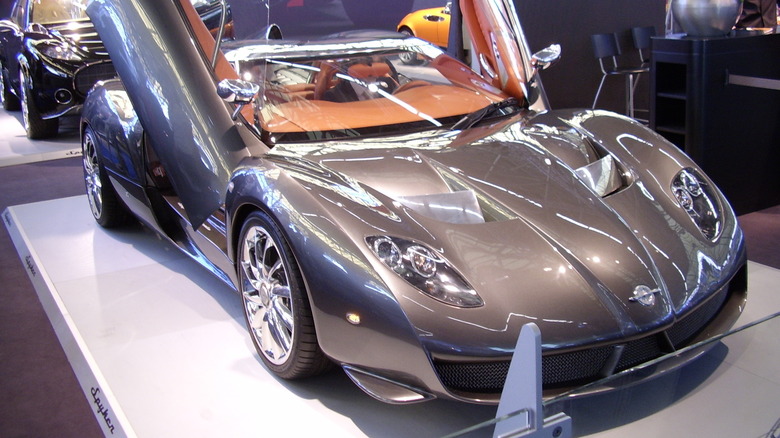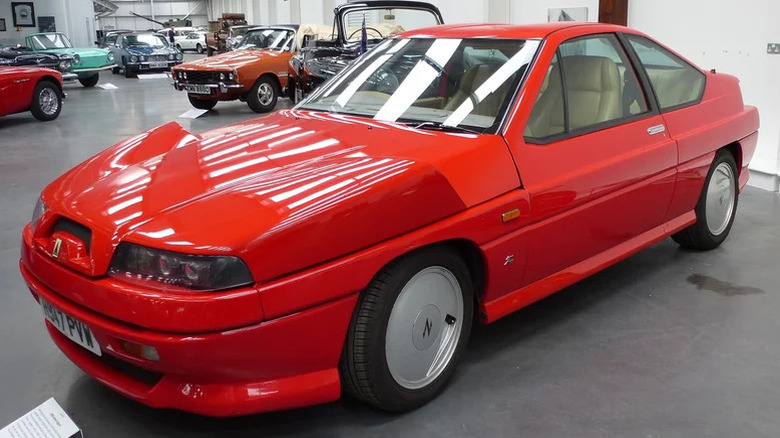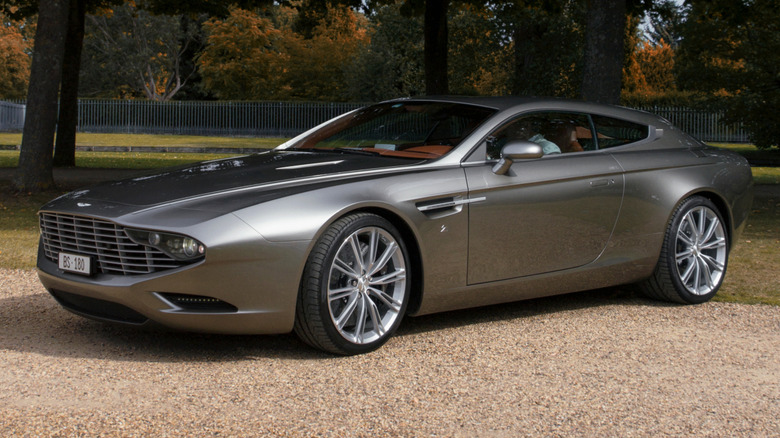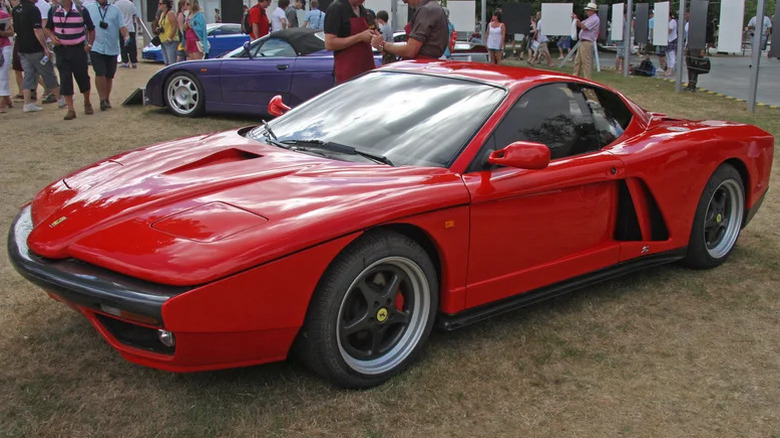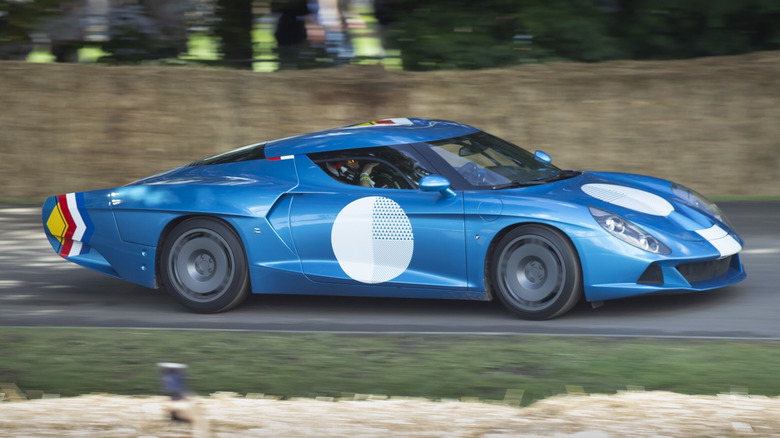13 Of The Wildest Looking Zagato Cars Ever Built
Zagato is one of the best-known Italian coachbuilders, with a history that stretches back over a hundred years. The company has been involved with the creation of many distinctive and polarizing cars over that time, both manufacturing and designing models to be sold under its own brand and those of its partners. Its in-house designs can often be identified thanks to the brand's signature double-bubble roof, with all manner of automobiles from British grand tourers to Japanese crossovers being subject to the Zagato treatment at some point or another.
Most –- although not all -– of Zagato's wildest cars are designed by the company itself, initially by its founder Ugo Zagato. Ugo's son Elio would take over the reins after his father's passing, employing a small but brilliant team including the likes of Ercole Spada and thus keeping Zagato at the cutting edge of the Italian design world.
Many of Zagato's cars aren't universally loved — in fact, quite the opposite is true. These 13 cars all have plenty of critics as well as fans, but whatever you think of them, their wild looks keep them among the most distinctive cars of their respective eras.
Alfa Romeo SZ
The Alfa Romeo SZ remains one of the most polarizing cars ever produced by the brand, and one of the most distinctive cars associated with Zagato. Of course, eagle-eyed enthusiasts will notice that Zagato's double-bubble roof is missing from the car. That's because the Alfa Romeo SZ was actually designed in-house at Alfa by Robert Opron, with Zagato only responsible for the final tweaks to its looks. It still bore the Zagato Z logo, however, since it was manufactured at the firm's production facility near Milan.
Although its design was unlike anything the brand had produced before, most of its mechanicals were not new. The brakes and suspension were borrowed from the brand's 75 Group A touring car, while the 3.0L Busso V6 engine could also be found in the 75 3.0i Quadrifoglio Verde sedan. The SZ's high asking price and divisive appearance kept it a relatively low seller over its three years on sale, with only just over 1,000 examples sold by the time it was discontinued in 1991. That rarity, alongside its unique looks, has meant that it's a sought-after collectors' car today.
Lamborghini 5-95 Zagato
Unveiled in 2014, the Lamborghini 5-95 Zagato is a Gallardo that's been given a thorough makeover by the Italian design house. It was reportedly built at the request of Albert Spiess, a notable Swiss car collector, and was inspired by the Zagato Raptor, another wild looking Zagato design that was intended to become a Lamborghini. Thanks to a change in the latter company's ownership, that never happened, and the Raptor remained a concept. With the 5-95 Zagato, Spiess envisioned a production version of the car made using a contemporary model.
The finished product is, to put it mildly, an acquired taste. It's certainly one of Zagato's most disjointed designs, and looks like several different cars when viewed from different angles. Its design was panned by the press at the time of its unveiling and it hasn't got any more likable with age, but at least it's one of the most unique Lamborghinis out there even if it's certainly not the prettiest.
It's not known exactly how many examples were built, but a small number have been spotted in the years since its unveiling. A yellow example with a gray interior was sold at a Gooding & Co auction in 2024, fetching $720,000, while the orange example commonly seen in photos was the original unveiled at the car's launch. A khaki green example with a H-pattern manual transmission and a white example with a tan interior have also been spotted wearing Japanese and Swiss license plates respectively.
[Featured image by Marco 56 via Wikimedia Commons | Cropped and scaled | CC BY 2.0]
Cadillac NART Zagato
Most auto enthusiasts associate the NART name with Ferrari, as NART's founder, Luigi Chinetti, was the exclusive American Ferrari dealer for more than two decades. Chinetti was instrumental in finding American buyers for the first Ferrari road cars, and set up NART (North American Racing Team) as a way to demonstrate to said buyers what Ferraris could do. However, by 1970, the outfit was looking to diversify, and so came up with the idea of creating a Cadillac-badged rival to Ferrari with the same Italian flair.
Chinetti roped in Zagato to help build the car, but the design was handled mostly by his son. Initially, GM bosses were supportive of the project, and even let NART handle its clay modeling at the GM design studio, but eventually the relationship between the two parties fell apart. Before the car could reach production, GM withdrew its support, leaving the Zagato-built prototype as the only example ever built.
There was no way that the car could have proceeded without GM's support –- it was built on the platform of the Eldorado, and featured GM's 472 cubic inch V8 engine. A few smaller parts were also borrowed from the Pontiac GTO, while others came from European carmakers thanks to Zagato's influence. With the car relying so heavily on GM running gear, the project was dead in the water as soon as the American automotive giant pulled out.
[Featured image by Simon Davison via Wikimedia Commons | Cropped and scaled | CC BY 2.0]
Ferrari 550 GTZ Barchetta
Many of Zagato's wildest cars are also among its rarest, with few more rare than the Ferrari 550 GTZ Barchetta. Only three examples of the car were built, with Zagato converting each example from a donor 550 Barchetta. The donor was in itself already a rare car, with only 448 examples built and each one individually numbered by Ferrari. Like many of Zagato's designs, the 550 GTZ Barchetta is a polarizing one.
It takes a much more rounded form than the donor car, with the revised headlights and taillights ensuring that almost nothing is carried over visually from the original. It bears a close resemblance to the 575 GTZ, an earlier limited-run special which effectively acted as the 550 GTZ Barchetta's hardtop counterpart despite both being based on different Ferrari models. The 575 GTZ was another very rare model, with only six examples produced.
That extreme rarity hasn't translated into sky-high resale prices for either variant of the car however, with a 550 GTZ Barchetta selling at a 2019 Bonhams auction for £575,000 (around $734,000 at the time). That wasn't much more than the previous owner reportedly paid for Zagato to convert the car into its current form.
Toyota Harrier Zagato
Toyota's back catalog is full of obscure and unusual models, with one of the rarest being the Toyota Harrier Zagato. The Toyota Harrier was the Japanese market version of the Lexus RX, and when it launched for the 1998 model year, the automaker wanted to make sure it grabbed as much attention as possible. The Harrier's styling was already different from anything else in the Toyota lineup, but to make it really stand out, Toyota enlisted the help of Zagato.
The Italian outfit designed a unique body kit for the Harrier which saw it gain a wider stance, new wheels, and a new front fascia among other tweaks. The car was then sold as a limited-run, top-spec Harrier trim in Toyopet dealerships, with only 250 examples available. Under the hood, the Harrier Zagato remained the same as any other well-specced Harrier, with a 3.0L V6 engine the only option. Modifying a crossover was always going to result in a divisive design, but it proved so successful that Toyota resurrected the collaboration for a second batch of Harrier specials a few years later in 2006.
Bentley Continental GTZ
From the back of the car, it's easy to draw parallels between the Bentley Continental GTZ and another Zagato car from the same era, the Ferrari 550 GTZ Barchetta. Both adopt similar lines with distinctive creases running through the taillights to accentuate the rear fenders. From the front, however, the Bentley is an altogether different beast. The regular Continental GT's grille is enlarged, encroaching on the space where the license plate once was.
The car's stock headlight design remains unchanged, but a new, prominent crease gives the car a more angular, squared-off look than stock. It all culminates in something that's still distinctly a Bentley, but is much more polarizing to look at than any of the British brand's regular GTs. Whether that's a good thing or not is down to personal taste, but a few wealthy buyers seemed to think so, as nine examples were built by Zagato.
One example appeared at an RM Sotheby's auction in 2022 and sold for 342,500 Swiss Francs, or around $359,000 at the time. That's less than the buyer reportedly paid for Zagato to convert the car in 2015, even without factoring in the cost of the original Bentley donor car.
Zagato Raptor
Lamborghini had already been bruised and battered by several years of financial uncertainty by the time the Zagato Raptor was unveiled. After falling out of favor with former owner Chrysler, Lamborghini was sold to Megatech, an Indonesian company linked to the ruler of the country at the time. Megatech consistently struggled to give Lamborghini the funding it needed, yet still planned overly ambitious expansions that had no hope of becoming reality. It was in this context that the Zagato Raptor was unveiled as the potential successor to the company's then-flagship supercar, the Diablo.
The Raptor looked significantly more futuristic than the Diablo, although underneath it shared a lot of its underlying design and mechanicals, including its V12 engine. Lamborghini's leadership intended on putting the car into production at the time, but never secured the funds to do so. Lamborghini was sold to Audi/VW in 1998, and its new bosses wanted a clean slate. The Raptor was scrapped and new investment was pumped into the company to create what would eventually become the Murcielago. The sole Raptor prototype later appeared at an RM Sotheby's auction and sold for over $1 million.
Spyker C12 Zagato
Unfortunately for Dutch carmaker Spyker, it has become best known in recent years for repeatedly going bankrupt and being passed between owners every few years without managing to fully get back on its feet. Before it ran out of cash, it produced several rare and striking cars, including the C12 Zagato. It was launched in 2007 at the Geneva Motor Show, with Spyker originally planning for 24 examples to be built. It's not clear how many examples were actually completed.
The car's unusual design drew a mixed reception at its unveiling -– Car Magazine described it as looking "like an ill-advised late night liaison between a 1950s jet car and a boat" – and its roughly $700,000 starting price also limited its appeal. The car was designed to commemorate Spyker's entry into Formula 1, but neither its automaking nor racing ventures would pan out quite to the brand's expectations. Spyker F1 was sold off after just over a year, eventually becoming Force India. Then, just a few short years after the C12 Zagato's unveiling, Spyker would buy Saab from GM and bankrupt itself in the process.
[Featured image by Joosthug via Wikimedia Commons | Cropped and scaled | CC BY-SA 3.0]
Zagato Zele 1000
While many of Zagato's cars cater towards the luxury end of the car market, the outfit has occasionally developed more affordable vehicles. Even these more affordable cars were designed to be unique, with the Zele 1000 city car proving to be particularly ahead of its time thanks to its electric powertrain. The car debuted at the Geneva Motor Show in 1972, and its unusual boxy design and 1,000W electric motor drew headlines at the time.
However, it would take until the events of 1973 for the car to be looked at seriously for production. The Oil Crisis was having significant effects across both Europe and America, and as a result, buyers were looking for alternatives to their gas-guzzling cars. The Zele 1000 fit the bill, since it was able to be plugged into a standard wall outlet to recharge overnight and could travel up to 50 miles between charges. Granted, it could only do so at a top speed of 25 mph, but then traffic in the most congested cities didn't move much faster anyway.
The car entered production in 1974 and around 500 examples were reportedly sold over the following two years. Only a small number remain in good condition today, with one such car appearing at an RM Sotheby's auction in 2018. It sold for £11,500, or around $15,350 at the time.
Autech Zagato Stelvio AZ-1
Undoubtedly one of the strangest Nissans ever built, the Autech Zagato Stelvio AZ-1 was a collaboration between Zagato and the Japanese automaker's tuning division Autech. The idea came about during the peak years of the Japanese economy in the late '80s, when Nissan had more development funds on hand than it knew what to do with. For some reason, it decided that the best thing to do would be to create an exclusive luxury car based on its existing Leopard coupe, which was sold as the Infiniti M30 in America.
Zagato's design for the car is certainly a bold step away from the Leopard's original design, and remains one of the Italian outfit's most love-it-or-hate-it cars. It's definitely not elegant, nor is it good looking by any traditional measure, but the design remains more of a head-turner than even many supercars today. Unsurprisingly, the Japanese-Italian creation was not a commercial hit during its production lifespan, and roughly 100 examples were sold before Nissan moved on from the project. Strangely enough, however, that wasn't the end of the two brands' partnership, as the even rarer Autech Gavia Zagato became as the AZ-1's spiritual successor.
[Featured image by Buch-t via Wikimedia Commons | Cropped and scaled | CC BY 3.0]
Aston Martin Virage Shooting Brake Zagato
Aston Martin and Zagato have a long history going back to the DB4 Zagato of the '60s. Over the decades, the pair have produced a long line of limited-run special edition cars. Zagato has also been responsible for producing a handful of privately commissioned Aston Martin one-offs, including the Aston Martin Virage Shooting Brake Zagato. It's a recent addition to the Aston Martin Zagato family, only being unveiled in 2013, but there's a good chance that many Aston Martin enthusiasts won't have heard of it.
The Aston Martin Virage Shooting Brake Zagato was built to celebrate 100 years of Aston Martin production, and was one of three one-off cars to emerge from the partnership within the space of a year. It was later transferred into private ownership in Switzerland, and has made sporadic public appearances since. Its shooting brake design gives it an extra layer of everyday practicality, but it's hard to imagine the car being used as anything other than a showpiece given its history and one-off status.
Ferrari FZ93 Zagato
Ferrari has a relatively small number of publicly unveiled concepts that didn't make it to production, at least compared to other manufacturers. It generally prefers to keep its designs hidden away from the public until they're ready to hit dealerships, but that doesn't stop collaborators like Zagato from unveiling their own takes on the Prancing Horse's cars. The FZ93 Zagato was, as its name suggests, unveiled in 1993, and was a collaboration between F (Ferrari) and Z (Zagato). It was based on the production 512 TR, but took design inspiration from Ferrari's Formula 1 car of the era.
The design was unveiled to lukewarm reviews, and so Ferrari bosses decided not to press ahead with a production version. The idea of taking Formula 1 styling cues and adapting it for a road car was later used to much greater success on the Enzo, which featured a similarly pointy nose to the FZ93 Zagato.
[Featured image by Brian Snelson via Wikimedia Commons | Cropped and scaled | CC BY 2.0]
Zagato AGTZ Twin Tail
The AGTZ Twin Tail is unusual even by Zagato standards. It's a rebodied Alpine A110 that was designed in collaboration with a Polish supercar dealer, and features stock internals and a removable rear end. It can be swapped from long tail to short tail form in a few minutes, giving the car two very different appearances. It was created to pay homage to the classic Alpine A220 that competed at Le Mans, and was reportedly inspired by its commissioner's desire for design creativity in a world of increasingly homogenized electric cars.
The car was unveiled in May 2024 and deliveries are scheduled for sometime in the fall, with a limited run of 19 examples set to be built. Pricing for the car will undoubtedly raise eyebrows considering it's a stock A110 underneath: it starts from €650,000 (around $717,000), plus taxes. That's ten times the starting price of a standard new A110. It's hard to know what's wilder — that Zagato designed a car with an entirely removable rear end just because it could or that it's charging such an eye-watering amount to own one.
[Featured image by Michele Borioli via Wikimedia Commons | Cropped and scaled | CC BY 2.0]
